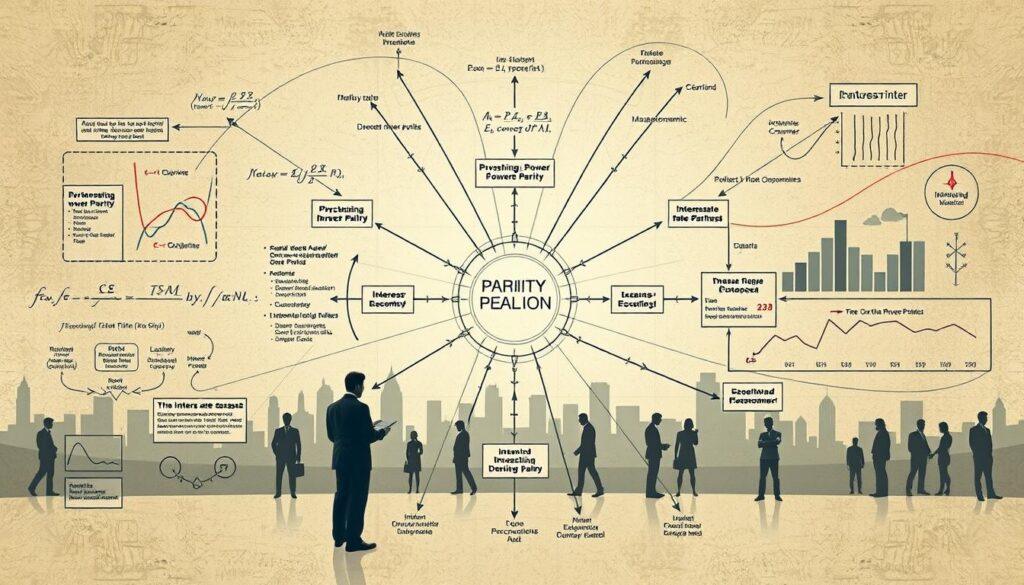The parity conditions mental model questions fairness in systems. The Mental Health Parity and Addiction Equity Act (MHPAEA) tried to make mental and physical care equal.
But, 40% of workers pay more for therapy than for broken-bone treatments, according to Kaiser data. This shows how gaps remain, even with laws based on mental models in economics.
Every economic choice, from healthcare to global markets, relies on parity conditions. The 2008 law was a big step, but 25% of employers don’t follow its rules. This model uncovers issues, like limited access to addiction meds or short mental health stays.
Discover how parity conditions affect real decisions.
Key Takeaways
- The 2008 law mandates mental health and physical care coverage must have equal restrictions.
- Only 10% of Americans with addictions receive treatment, despite parity laws.
- EBSA’s delayed compliance tool shows risks in enforcing parity requirements.
- 40% of workers pay more for mental health care than physical care (Kaiser study).
- 36% of adults with mental illness didn’t get services in 2023 (SAMHSA data).
Understanding the Parity Conditions Mental Model and Its Origins
The parity conditions mental model started as a financial idea. Early economists looked at how markets balance prices. This idea of balance grew into a tool for finding unfairness in systems.
Today, it’s a strategic thinking framework based on behavioral economics. It helps people see hidden biases in their decisions.
“Over 25 years after the first federal mental health parity protections were implemented.”
The model’s legal roots go back to the 2008 Mental Health Parity and Addiction Equity Act. By 2010, the ACA made mental health coverage as good as physical care. But recent rule changes could change this.
These changes matter because parity laws now affect 90% of insured adults with behavioral health needs. Yet, 53 million Americans couldn’t get care in 2018. This shows how far we are from true equality.
Behind the scenes, behavioral economics explains why people resist parity. For example, insurers often limit mental health provider networks. This creates hidden barriers. The parity conditions mental model teaches you to spot these imbalances.
In 2020, insurers paid $1 million to settle a Massachusetts parity violation case. This case was about underpaid therapy visits.
Learning this model’s history gives you tools to challenge unfair policies. Its rules, like equal treatment for mental and physical care, are now in laws. But real-world gaps persist. Mastering this model helps you advocate for fair systems and better decisions.
How the Parity Conditions Mental Model Works in Economic Decision-Making

The parity conditions mental model is a decision-making framework that keeps economic systems balanced. It uses rational decision-making to check if things like interest rates or coverage limits are fair. This helps professionals in finance or healthcare avoid unfairness to consumers or markets.
Four Key Principles of Parity Conditions
Think of balancing two scales. Each principle makes sure different parts of an economy are equal. For instance, interest rate parity connects currency exchange rates to interest rate differences.
Purchasing power parity compares prices of goods in different places. These rules are key to mental models in economics, guiding decisions from global trade to insurance.
Mathematical Foundations Behind the Model
Equations like the international Fisher effect link interest rates to currency values. These formulas might seem complex, but they’re based on simple ideas. If two systems aren’t equal, there’s a chance to fix it. It’s like solving puzzles where every piece must fit perfectly.
Real-World Examples of Parity Conditions in Action
In healthcare, the Mental Health Parity and Addiction Equity (MHPAEA) ensures equal coverage for mental and physical health. Yet, only 47.8% of U.S. teens with major depression get help. New 2023 rules require insurers to share detailed payment data, highlighting gaps.
These steps show how behavioral economics shapes real policies.
Whether it’s managing global currencies or healthcare benefits, parity conditions make systems align. This strategic thinking ensures decisions are effective, not just theoretical.
Applying the Parity Conditions Mental Model to Improve Your Strategic Thinking
Strategic thinking needs clarity to navigate uncertainty. The parity conditions mental model is a decision-making framework that fights cognitive biases like overconfidence or heuristic reasoning. It helps you make choices based on facts, not just feelings.
For example, it stops you from overestimating recent trends (recency bias). By comparing outcomes under different scenarios, it grounds your decisions in rational analysis.
Financial decisions become more precise with parity principles. Think about evaluating currency exchange rates. Parity conditions show where prices should be equal. This is like how insurers assess risks to avoid mental model gaps.
Use parity to find arbitrage opportunities or price imbalances. This ensures your choices are based on rational decision-making.
Combining parity with other mental models boosts results. Pair it with opportunity cost analysis or Nash equilibrium strategies for complex systems. Like the WHO’s supply and demand approach to healthcare parity, integrating models reveals hidden trade-offs.
For example, merging parity with time value of money calculations helps understand long-term financial trade-offs.
Remember, parity is part of a toolkit, not a standalone tool. By using multiple models, you reduce blind spots in cognitive psychology. Start small: apply parity to one choice this week and see how it improves your strategic thinking.
Benefits and Limitations of Using the Parity Conditions Mental Model
The Parity Conditions Mental Model helps you make better financial and strategic decisions. It highlights arbitrage opportunities and fights cognitive biases in planning. It shows when markets match expectations with reality, keeping your choices rational.
For example, laws like the MHPAEA have cut down costs for mental health care. This shows how parity can lead to real change.

But, the model has its limits. It assumes markets are perfect, which isn’t always true. Real-world heuristic reasoning and behavioral economics factors like fear or habit can influence decisions.
Even with parity laws, like banning annual visit caps, following complex rules is hard. Laws in California (SB 855) and Illinois (2021 Act) try to fix this. But, they show the ongoing struggle with rules.
| Benefits | Limitations |
|---|---|
| Identifies gaps in coverage parity | Assumes perfect market data |
| Reduces cost disparities for mental health | Struggles with NQTL compliance tracking |
| Aligns with federal parity laws (MHPAEA, ACA) | Doesn’t account for psychological biases in real choices |
Parity models are best when used with insights from behavioral economics. They’ve helped improve access to care, like for depression or bipolar disorder. But, they fail when cognitive biases take over.
States are trying to fix this by setting clear standards. But, the fast-changing markets make it hard to stick to strict parity rules. Use the model as a guide, not a strict rule, to balance data with human behavior.
Conclusion: Mastering the Parity Conditions Mental Model for Better Decision-Making
Using the Parity Conditions Mental Model boosts your strategic thinking. It makes sure your decisions are fair and based on solid evidence. This approach helps you avoid biases, like those in healthcare where many rural Americans can’t get mental health help.
By applying its rules, you can spot and fix unfair policies or treatment gaps. This is key in fields where fairness is often overlooked.
Data reveals that 40% of people shy away from mental health care because of stigma. This leads to more deaths and worse health outcomes. The Mental Health Parity and Addiction Equity Act (MHPAEA) aims to treat mental and physical health equally. Yet, unfair treatment remains a big issue.
For example, overdose deaths jumped by 36,000 in 2021. This shows how urgent it is to make fair decisions in healthcare.
Understanding parity conditions means seeing how biases affect patient care. Studies show that biases in doctor attitudes can lower patient confidence by 40%. This hurts recovery efforts.
Tools like the Chronic Care Model have shown to improve health outcomes by 20%. It’s clear that structured methods can make a difference. Begin by checking your own decisions. Ask if they’re fair and based on data, not just guesses.
Whether it’s tackling opioid crises or mental health stigma, this model gives you the power to push for fair policies. By using parity thinking in your daily choices, you help create systems where more patients get the care they need.
And fewer suffer from avoidable setbacks.


